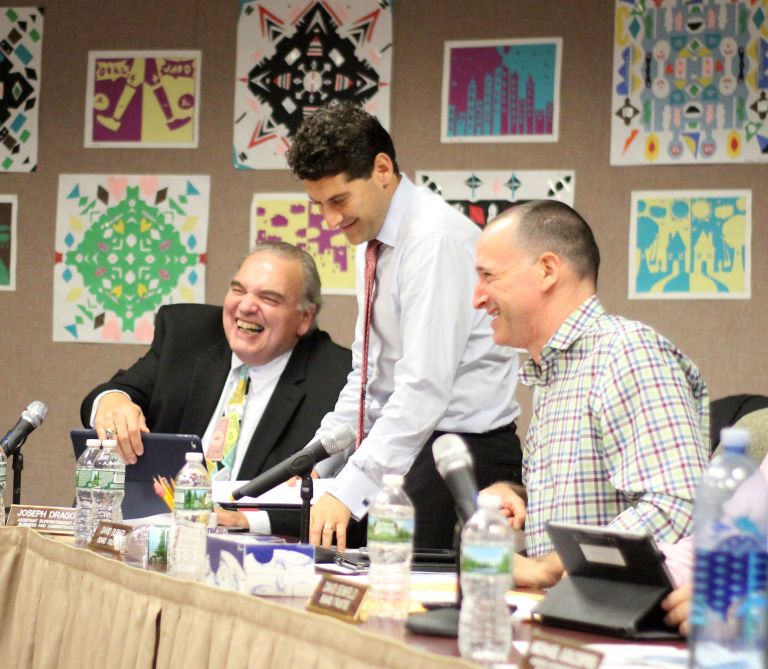
Common Core test results improved from the prior year’s scores for English Language Arts and remained consistent for math in grades 3-8 of the Roslyn school district in 2015-16, but opt-outs increased for each test, Michael Goldspiel, the assistant superintendent for secondary education, said in a presentation last Thursday night.
He warned against drawing conclusions from the results.
“We cannot compare this year’s test scores to last year’s,” he said, “because the tests changed and more students opted out.”
In the 2015-16 school year opt-outs were up 38 percent for the English Language Arts test and up 36 percent for the math test from 2014-15.
School Superintendent Alison Brown said she wasn’t surprised by the opt-outs. “If the testing becomes valid and reliable then kids should take the test,” she said. “Right now we’re not even allowed to make decisions about kids with the data.”
But Goldspiel affirmed his support for Common Core. “We think Common Core is a great thing because it teaches critical thinking,” he said.
He noted that students improved on the English Language Arts test, with 61 percent performing at a proficient level in 2014-15 and 67 percent doing so in 2015-16. The scores revealed large disparities between different racial and socioeconomic groups, however. While 75 percent of Asian and Pacific Islander students performed at a proficient level and 69 percent of white students did the same, just 48 percent of Hispanic students and 31 percent of black students were deemed proficient. Only 45 percent of economically disadvantaged students performed at or above the proficiency standard.
Similar racial and socioeconomic disparities appeared in the Common Core grades 3-8 math test results. Overall, 75 percent of students performed at a proficient level in the 2015-16 school year, the same number as in 2014-15.
Goldspiel also announced the results of Common Core Regents tests, which high school students take in the second semester of their junior year. Such tests range in subject matter from chemistry to U.S. history to algebra.
The percentage of students who performed at a passing level as compared with the previous year either increased by a few percentage points, remained consistent, or decreased by a few percentage points for a majority of the tests. Notable improvement occurred on the algebra and physics tests, as the percentage of passing students increased from 2014-15 to 2015-16 by six points on the former and five points on the latter. A drop-off of six percentage points occurred on the Algebra II/Trigonometry test between 2014-15 and 2015-16.
Goldspiel said that the total of 451 Roslyn high school students who took an AP test in 2015-16 was higher than in any prior year. The number of Roslyn students who take an AP test in a given year has gone up annually since 2011-12, when 380 students took at least one AP test.
Goldspiel credited the expansion of AP classes offered at the school as well as the district’s encouraging students to take AP classes either on their own accord or after a teacher recommendation.
Brown acknowledged that students who choose on their own to take an AP class are less likely to pass than those who are recommended for one by a teacher. But she added that the school is always improving its support for students who take a risk in challenging themselves with an AP class.
Brown made a short presentation about the most recent statistics on the district’s demographics, as of Oct. 7, 2015. There were 3,156 students in the district, she said, of whom 72.7 percent were white, 16.3 percent were Asian/Pacific Islander, 7 percent were Hispanic, 3.4 percent were black and 0.6 percent were multiracial. Of the total, 9.2 percent of students had disabilities and 11.8 percent were economically disadvantaged.
She proudly pointed to the school district’s 97 percent graduation rate in 2015-16, which was consistent with prior years. The Roslyn Board of Education president, Meryl Waxman Ben-Levy, said “the remaining 3 percent is just as important” and “the school district needs to see what it can do to support those students.”
While the school district experienced a high graduation rate, it also had high rates of absenteeism. Twenty-three percent of students were marked absent for 5 to 9 percent of the 2015-16 school year, and 6 percent were marked absent for 10 percent of the school year.
“This is something to keep an eye on and minimize,” Brown said.






